Vojinović Tower
Vojinović Tower (Serbian: Војиновића Кула, Vojinovića Kula) or Old Tower (Albanian: Kulla e Vjetër) or Vučitrn (English: Wolf thorn) is a city fortifications in Vučitrn, Kosovo.[lower-alpha 1] It was the seat of despot Đurađ Branković (1427–1456). Later chroniclers (Ami Boué, Aleksandar Giljferding) are noted that the fort itself is derived from the times of Dušan, and that it is an old fortress with a tower in the middle of the town.[1]
| Vojinović Tower Војиновића кула | |
|---|---|
| Vučitrn, Kosovo[lower-alpha 1] | |
 Vojinović tower, interior court | |
| Type | Strategic fortification |
| Site information | |
| Open to the public | Yes |
| Site history | |
| Built by | Stefan Dušan, Đurađ Branković |
| Materials | Stone |
Vojinović Tower

Today, of the entire fort survived only Donjon Tower that the people called Vojinović Tower with part of wall in the form of a square. On that walls (thick about 3 m), the remains of Machicolation, Putlog holes or Hoardings can be seen, and in addition to the closed ground, had the floor, over which there was an open top of the tower with battlement on. As all Donjon, Vojinović Tower also had no entrance in the basement, but only on the floor with the southern side and it is approached by wooden stairs that in a case of emergency could be easily removed.[2]
Remains

Most of the former capital of Đurađ Branković disappeared during Ottoman period when the space fortress became the seat of government and administrative Bey, while the ground floor of the tower used as a warehouse for the grain (barley, corn, wheat) that are collected on behalf of Bey taxes. Former entrance gates, located next to the tower (at a distance of 1m) in North wall and has semicircle shape, was embowered and immured, and instead of that one, new was opened on the East wall.
Today, of the whole former fortress survived only Donjon Tower with walls around it to form a square courtyard base. Their height is 4 m - 5 m, with the exception of southern wall that faces the main street with the bottom of the slope (height 1.2m - 1.5m, sally 0.35m - 0.4 m) whose height is 6 m - 7 m.
Vojinović Tower was declared Monument of Culture of Exceptional Importance in 1990, and it is protected by the Republic of Serbia.[3]
Notes
- Kosovo is the subject of a territorial dispute between the Republic of Kosovo and the Republic of Serbia. The Republic of Kosovo unilaterally declared independence on 17 February 2008. Serbia continues to claim it as part of its own sovereign territory. The two governments began to normalise relations in 2013, as part of the 2013 Brussels Agreement. Kosovo is currently recognized as an independent state by 99 out of the 193 United Nations member states. In total, 113 UN member states recognized Kosovo at some point, of which 14 later withdrew their recognition.
References
- Aleksandar Deroko, Medieval towns in Serbia, Montenegro and Macedonia, Belgrade 1950.
- Ivan Zdravkovic, Medieval towns and castles in Kosovo, Belgrade 1975.
- Monuments of Culture in Serbia: СРЕДЊОВЕКОВНИ УТВРЂЕНИ ДВОРАЦ (ВОЈИНОВИЋА КУЛА) (SANU) (in Serbian and English)

